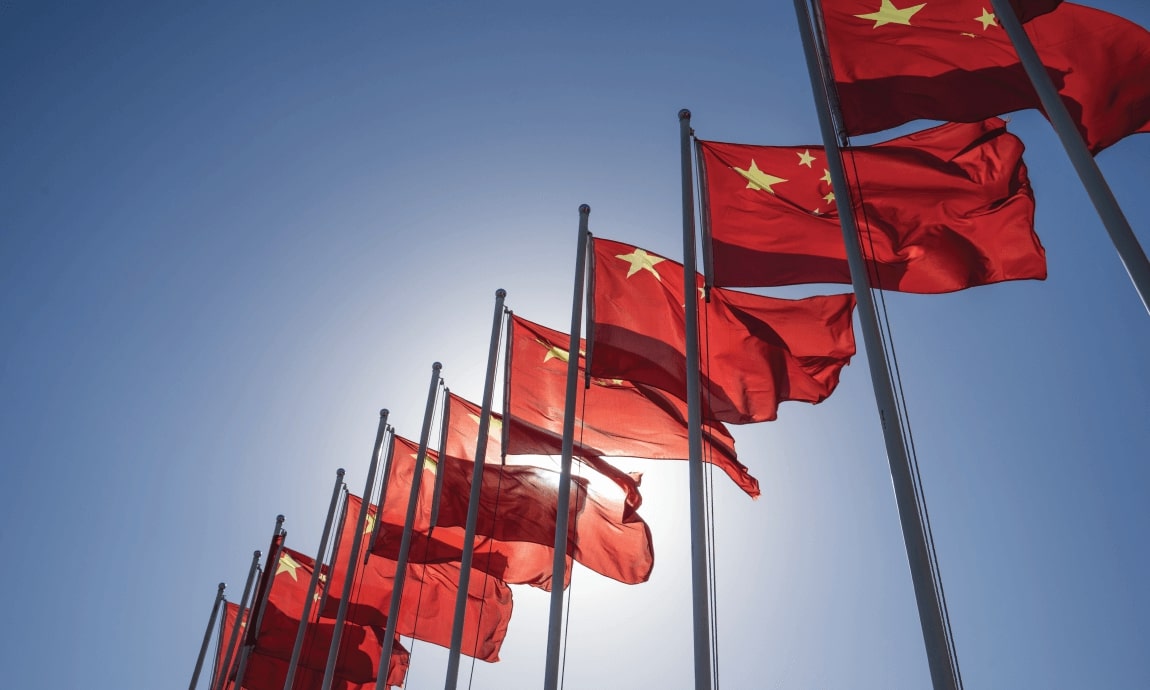China’s weakness in factory and services readings came to confirm the general contracting economic activity across Asia, and that the post-pandemic recovery is losing steam, with Japan reporting a surprise decline in output and retail sales, and South Korea posting lower production.
According to the official data, chemical, ferrous metal smelting, and rolling processing industries faced significant declines in production and demand, while in the services sector, rail and air transport, accommodation and catering sectors remained in the expansion, on the back of strong May Labor Day travel, while real estate activity fell.
China’s weakness in factory and services readings came to confirm the general contracting economic activity across Asia, and that the post-pandemic recovery is losing steam, with Japan reporting a surprise decline in output and retail sales, and South Korea posting lower production.
According to the official data, chemical, ferrous metal smelting, and rolling processing industries faced significant declines in production and demand, while in the services sector, rail and air transport, accommodation and catering sectors remained in the expansion, on the back of strong May Labor Day travel, while real estate activity fell.
China’s weakness in factory and services readings came to confirm the general contracting economic activity across Asia, and that the post-pandemic recovery is losing steam, with Japan reporting a surprise decline in output and retail sales, and South Korea posting lower production.
According to the official data, chemical, ferrous metal smelting, and rolling processing industries faced significant declines in production and demand, while in the services sector, rail and air transport, accommodation and catering sectors remained in the expansion, on the back of strong May Labor Day travel, while real estate activity fell.
China’s weakness in factory and services readings came to confirm the general contracting economic activity across Asia, and that the post-pandemic recovery is losing steam, with Japan reporting a surprise decline in output and retail sales, and South Korea posting lower production.
Adding to that, the service sector activity expanded at the slowest pace in four months in May, with the official non-manufacturing PMI falling to 54.5 from 56.4 in April, and well below the forecasted expansion of 55.1.
According to the official data, chemical, ferrous metal smelting, and rolling processing industries faced significant declines in production and demand, while in the services sector, rail and air transport, accommodation and catering sectors remained in the expansion, on the back of strong May Labor Day travel, while real estate activity fell.
China’s weakness in factory and services readings came to confirm the general contracting economic activity across Asia, and that the post-pandemic recovery is losing steam, with Japan reporting a surprise decline in output and retail sales, and South Korea posting lower production.
Adding to that, the service sector activity expanded at the slowest pace in four months in May, with the official non-manufacturing PMI falling to 54.5 from 56.4 in April, and well below the forecasted expansion of 55.1.
According to the official data, chemical, ferrous metal smelting, and rolling processing industries faced significant declines in production and demand, while in the services sector, rail and air transport, accommodation and catering sectors remained in the expansion, on the back of strong May Labor Day travel, while real estate activity fell.
China’s weakness in factory and services readings came to confirm the general contracting economic activity across Asia, and that the post-pandemic recovery is losing steam, with Japan reporting a surprise decline in output and retail sales, and South Korea posting lower production.
The official manufacturing purchasing managers’ index (PMI) fell to a five-month low of 48.8, down from 49.2 in April and below the 50-point mark that separates expansion from contraction. The PMI also dashed forecasts for an increase to 49.4.
Adding to that, the service sector activity expanded at the slowest pace in four months in May, with the official non-manufacturing PMI falling to 54.5 from 56.4 in April, and well below the forecasted expansion of 55.1.
According to the official data, chemical, ferrous metal smelting, and rolling processing industries faced significant declines in production and demand, while in the services sector, rail and air transport, accommodation and catering sectors remained in the expansion, on the back of strong May Labor Day travel, while real estate activity fell.
China’s weakness in factory and services readings came to confirm the general contracting economic activity across Asia, and that the post-pandemic recovery is losing steam, with Japan reporting a surprise decline in output and retail sales, and South Korea posting lower production.
The official manufacturing purchasing managers’ index (PMI) fell to a five-month low of 48.8, down from 49.2 in April and below the 50-point mark that separates expansion from contraction. The PMI also dashed forecasts for an increase to 49.4.
Adding to that, the service sector activity expanded at the slowest pace in four months in May, with the official non-manufacturing PMI falling to 54.5 from 56.4 in April, and well below the forecasted expansion of 55.1.
According to the official data, chemical, ferrous metal smelting, and rolling processing industries faced significant declines in production and demand, while in the services sector, rail and air transport, accommodation and catering sectors remained in the expansion, on the back of strong May Labor Day travel, while real estate activity fell.
China’s weakness in factory and services readings came to confirm the general contracting economic activity across Asia, and that the post-pandemic recovery is losing steam, with Japan reporting a surprise decline in output and retail sales, and South Korea posting lower production.
The weaker-than-expected China PMI manufacturing activity in May has given sellers more ammo to pressure Chinese stocks lower today.
The official manufacturing purchasing managers’ index (PMI) fell to a five-month low of 48.8, down from 49.2 in April and below the 50-point mark that separates expansion from contraction. The PMI also dashed forecasts for an increase to 49.4.
Adding to that, the service sector activity expanded at the slowest pace in four months in May, with the official non-manufacturing PMI falling to 54.5 from 56.4 in April, and well below the forecasted expansion of 55.1.
According to the official data, chemical, ferrous metal smelting, and rolling processing industries faced significant declines in production and demand, while in the services sector, rail and air transport, accommodation and catering sectors remained in the expansion, on the back of strong May Labor Day travel, while real estate activity fell.
China’s weakness in factory and services readings came to confirm the general contracting economic activity across Asia, and that the post-pandemic recovery is losing steam, with Japan reporting a surprise decline in output and retail sales, and South Korea posting lower production.
The weaker-than-expected China PMI manufacturing activity in May has given sellers more ammo to pressure Chinese stocks lower today.
The official manufacturing purchasing managers’ index (PMI) fell to a five-month low of 48.8, down from 49.2 in April and below the 50-point mark that separates expansion from contraction. The PMI also dashed forecasts for an increase to 49.4.
Adding to that, the service sector activity expanded at the slowest pace in four months in May, with the official non-manufacturing PMI falling to 54.5 from 56.4 in April, and well below the forecasted expansion of 55.1.
According to the official data, chemical, ferrous metal smelting, and rolling processing industries faced significant declines in production and demand, while in the services sector, rail and air transport, accommodation and catering sectors remained in the expansion, on the back of strong May Labor Day travel, while real estate activity fell.
China’s weakness in factory and services readings came to confirm the general contracting economic activity across Asia, and that the post-pandemic recovery is losing steam, with Japan reporting a surprise decline in output and retail sales, and South Korea posting lower production.
Deteriorating economic activity in China:
The weaker-than-expected China PMI manufacturing activity in May has given sellers more ammo to pressure Chinese stocks lower today.
The official manufacturing purchasing managers’ index (PMI) fell to a five-month low of 48.8, down from 49.2 in April and below the 50-point mark that separates expansion from contraction. The PMI also dashed forecasts for an increase to 49.4.
Adding to that, the service sector activity expanded at the slowest pace in four months in May, with the official non-manufacturing PMI falling to 54.5 from 56.4 in April, and well below the forecasted expansion of 55.1.
According to the official data, chemical, ferrous metal smelting, and rolling processing industries faced significant declines in production and demand, while in the services sector, rail and air transport, accommodation and catering sectors remained in the expansion, on the back of strong May Labor Day travel, while real estate activity fell.
China’s weakness in factory and services readings came to confirm the general contracting economic activity across Asia, and that the post-pandemic recovery is losing steam, with Japan reporting a surprise decline in output and retail sales, and South Korea posting lower production.
Deteriorating economic activity in China:
The weaker-than-expected China PMI manufacturing activity in May has given sellers more ammo to pressure Chinese stocks lower today.
The official manufacturing purchasing managers’ index (PMI) fell to a five-month low of 48.8, down from 49.2 in April and below the 50-point mark that separates expansion from contraction. The PMI also dashed forecasts for an increase to 49.4.
Adding to that, the service sector activity expanded at the slowest pace in four months in May, with the official non-manufacturing PMI falling to 54.5 from 56.4 in April, and well below the forecasted expansion of 55.1.
According to the official data, chemical, ferrous metal smelting, and rolling processing industries faced significant declines in production and demand, while in the services sector, rail and air transport, accommodation and catering sectors remained in the expansion, on the back of strong May Labor Day travel, while real estate activity fell.
China’s weakness in factory and services readings came to confirm the general contracting economic activity across Asia, and that the post-pandemic recovery is losing steam, with Japan reporting a surprise decline in output and retail sales, and South Korea posting lower production.
All major indices have erased almost half of their post-pandemic gains (nearly 20%) of Q4 2022 triggered by the optimism over the reopening of the Chinese economy after 3 years of pandemic lockdowns and the prospects of a post-Covid economic and manufacturing recovery, which has quickly faded.
Deteriorating economic activity in China:
The weaker-than-expected China PMI manufacturing activity in May has given sellers more ammo to pressure Chinese stocks lower today.
The official manufacturing purchasing managers’ index (PMI) fell to a five-month low of 48.8, down from 49.2 in April and below the 50-point mark that separates expansion from contraction. The PMI also dashed forecasts for an increase to 49.4.
Adding to that, the service sector activity expanded at the slowest pace in four months in May, with the official non-manufacturing PMI falling to 54.5 from 56.4 in April, and well below the forecasted expansion of 55.1.
According to the official data, chemical, ferrous metal smelting, and rolling processing industries faced significant declines in production and demand, while in the services sector, rail and air transport, accommodation and catering sectors remained in the expansion, on the back of strong May Labor Day travel, while real estate activity fell.
China’s weakness in factory and services readings came to confirm the general contracting economic activity across Asia, and that the post-pandemic recovery is losing steam, with Japan reporting a surprise decline in output and retail sales, and South Korea posting lower production.
All major indices have erased almost half of their post-pandemic gains (nearly 20%) of Q4 2022 triggered by the optimism over the reopening of the Chinese economy after 3 years of pandemic lockdowns and the prospects of a post-Covid economic and manufacturing recovery, which has quickly faded.
Deteriorating economic activity in China:
The weaker-than-expected China PMI manufacturing activity in May has given sellers more ammo to pressure Chinese stocks lower today.
The official manufacturing purchasing managers’ index (PMI) fell to a five-month low of 48.8, down from 49.2 in April and below the 50-point mark that separates expansion from contraction. The PMI also dashed forecasts for an increase to 49.4.
Adding to that, the service sector activity expanded at the slowest pace in four months in May, with the official non-manufacturing PMI falling to 54.5 from 56.4 in April, and well below the forecasted expansion of 55.1.
According to the official data, chemical, ferrous metal smelting, and rolling processing industries faced significant declines in production and demand, while in the services sector, rail and air transport, accommodation and catering sectors remained in the expansion, on the back of strong May Labor Day travel, while real estate activity fell.
China’s weakness in factory and services readings came to confirm the general contracting economic activity across Asia, and that the post-pandemic recovery is losing steam, with Japan reporting a surprise decline in output and retail sales, and South Korea posting lower production.
The resumed tension between U.S. and China after Beijing declined a Washington request for a meeting between defense ministers has been also weighing on the investment sentiment for Chinese markets.
All major indices have erased almost half of their post-pandemic gains (nearly 20%) of Q4 2022 triggered by the optimism over the reopening of the Chinese economy after 3 years of pandemic lockdowns and the prospects of a post-Covid economic and manufacturing recovery, which has quickly faded.
Deteriorating economic activity in China:
The weaker-than-expected China PMI manufacturing activity in May has given sellers more ammo to pressure Chinese stocks lower today.
The official manufacturing purchasing managers’ index (PMI) fell to a five-month low of 48.8, down from 49.2 in April and below the 50-point mark that separates expansion from contraction. The PMI also dashed forecasts for an increase to 49.4.
Adding to that, the service sector activity expanded at the slowest pace in four months in May, with the official non-manufacturing PMI falling to 54.5 from 56.4 in April, and well below the forecasted expansion of 55.1.
According to the official data, chemical, ferrous metal smelting, and rolling processing industries faced significant declines in production and demand, while in the services sector, rail and air transport, accommodation and catering sectors remained in the expansion, on the back of strong May Labor Day travel, while real estate activity fell.
China’s weakness in factory and services readings came to confirm the general contracting economic activity across Asia, and that the post-pandemic recovery is losing steam, with Japan reporting a surprise decline in output and retail sales, and South Korea posting lower production.
The resumed tension between U.S. and China after Beijing declined a Washington request for a meeting between defense ministers has been also weighing on the investment sentiment for Chinese markets.
All major indices have erased almost half of their post-pandemic gains (nearly 20%) of Q4 2022 triggered by the optimism over the reopening of the Chinese economy after 3 years of pandemic lockdowns and the prospects of a post-Covid economic and manufacturing recovery, which has quickly faded.
Deteriorating economic activity in China:
The weaker-than-expected China PMI manufacturing activity in May has given sellers more ammo to pressure Chinese stocks lower today.
The official manufacturing purchasing managers’ index (PMI) fell to a five-month low of 48.8, down from 49.2 in April and below the 50-point mark that separates expansion from contraction. The PMI also dashed forecasts for an increase to 49.4.
Adding to that, the service sector activity expanded at the slowest pace in four months in May, with the official non-manufacturing PMI falling to 54.5 from 56.4 in April, and well below the forecasted expansion of 55.1.
According to the official data, chemical, ferrous metal smelting, and rolling processing industries faced significant declines in production and demand, while in the services sector, rail and air transport, accommodation and catering sectors remained in the expansion, on the back of strong May Labor Day travel, while real estate activity fell.
China’s weakness in factory and services readings came to confirm the general contracting economic activity across Asia, and that the post-pandemic recovery is losing steam, with Japan reporting a surprise decline in output and retail sales, and South Korea posting lower production.
Hang Seng index, Daily chart
The resumed tension between U.S. and China after Beijing declined a Washington request for a meeting between defense ministers has been also weighing on the investment sentiment for Chinese markets.
All major indices have erased almost half of their post-pandemic gains (nearly 20%) of Q4 2022 triggered by the optimism over the reopening of the Chinese economy after 3 years of pandemic lockdowns and the prospects of a post-Covid economic and manufacturing recovery, which has quickly faded.
Deteriorating economic activity in China:
The weaker-than-expected China PMI manufacturing activity in May has given sellers more ammo to pressure Chinese stocks lower today.
The official manufacturing purchasing managers’ index (PMI) fell to a five-month low of 48.8, down from 49.2 in April and below the 50-point mark that separates expansion from contraction. The PMI also dashed forecasts for an increase to 49.4.
Adding to that, the service sector activity expanded at the slowest pace in four months in May, with the official non-manufacturing PMI falling to 54.5 from 56.4 in April, and well below the forecasted expansion of 55.1.
According to the official data, chemical, ferrous metal smelting, and rolling processing industries faced significant declines in production and demand, while in the services sector, rail and air transport, accommodation and catering sectors remained in the expansion, on the back of strong May Labor Day travel, while real estate activity fell.
China’s weakness in factory and services readings came to confirm the general contracting economic activity across Asia, and that the post-pandemic recovery is losing steam, with Japan reporting a surprise decline in output and retail sales, and South Korea posting lower production.
Hang Seng index, Daily chart
The resumed tension between U.S. and China after Beijing declined a Washington request for a meeting between defense ministers has been also weighing on the investment sentiment for Chinese markets.
All major indices have erased almost half of their post-pandemic gains (nearly 20%) of Q4 2022 triggered by the optimism over the reopening of the Chinese economy after 3 years of pandemic lockdowns and the prospects of a post-Covid economic and manufacturing recovery, which has quickly faded.
Deteriorating economic activity in China:
The weaker-than-expected China PMI manufacturing activity in May has given sellers more ammo to pressure Chinese stocks lower today.
The official manufacturing purchasing managers’ index (PMI) fell to a five-month low of 48.8, down from 49.2 in April and below the 50-point mark that separates expansion from contraction. The PMI also dashed forecasts for an increase to 49.4.
Adding to that, the service sector activity expanded at the slowest pace in four months in May, with the official non-manufacturing PMI falling to 54.5 from 56.4 in April, and well below the forecasted expansion of 55.1.
According to the official data, chemical, ferrous metal smelting, and rolling processing industries faced significant declines in production and demand, while in the services sector, rail and air transport, accommodation and catering sectors remained in the expansion, on the back of strong May Labor Day travel, while real estate activity fell.
China’s weakness in factory and services readings came to confirm the general contracting economic activity across Asia, and that the post-pandemic recovery is losing steam, with Japan reporting a surprise decline in output and retail sales, and South Korea posting lower production.
Hang Seng index, Daily chart
The resumed tension between U.S. and China after Beijing declined a Washington request for a meeting between defense ministers has been also weighing on the investment sentiment for Chinese markets.
All major indices have erased almost half of their post-pandemic gains (nearly 20%) of Q4 2022 triggered by the optimism over the reopening of the Chinese economy after 3 years of pandemic lockdowns and the prospects of a post-Covid economic and manufacturing recovery, which has quickly faded.
Deteriorating economic activity in China:
The weaker-than-expected China PMI manufacturing activity in May has given sellers more ammo to pressure Chinese stocks lower today.
The official manufacturing purchasing managers’ index (PMI) fell to a five-month low of 48.8, down from 49.2 in April and below the 50-point mark that separates expansion from contraction. The PMI also dashed forecasts for an increase to 49.4.
Adding to that, the service sector activity expanded at the slowest pace in four months in May, with the official non-manufacturing PMI falling to 54.5 from 56.4 in April, and well below the forecasted expansion of 55.1.
According to the official data, chemical, ferrous metal smelting, and rolling processing industries faced significant declines in production and demand, while in the services sector, rail and air transport, accommodation and catering sectors remained in the expansion, on the back of strong May Labor Day travel, while real estate activity fell.
China’s weakness in factory and services readings came to confirm the general contracting economic activity across Asia, and that the post-pandemic recovery is losing steam, with Japan reporting a surprise decline in output and retail sales, and South Korea posting lower production.
Mainland’s indices Shanghai Shenzhen CSI 300 and Shanghai Composite also fell 1% and 0.6%, respectively, to their lowest since the end of November 2022, closing between 3.6% and 6% lower for May.
Hang Seng index, Daily chart
The resumed tension between U.S. and China after Beijing declined a Washington request for a meeting between defense ministers has been also weighing on the investment sentiment for Chinese markets.
All major indices have erased almost half of their post-pandemic gains (nearly 20%) of Q4 2022 triggered by the optimism over the reopening of the Chinese economy after 3 years of pandemic lockdowns and the prospects of a post-Covid economic and manufacturing recovery, which has quickly faded.
Deteriorating economic activity in China:
The weaker-than-expected China PMI manufacturing activity in May has given sellers more ammo to pressure Chinese stocks lower today.
The official manufacturing purchasing managers’ index (PMI) fell to a five-month low of 48.8, down from 49.2 in April and below the 50-point mark that separates expansion from contraction. The PMI also dashed forecasts for an increase to 49.4.
Adding to that, the service sector activity expanded at the slowest pace in four months in May, with the official non-manufacturing PMI falling to 54.5 from 56.4 in April, and well below the forecasted expansion of 55.1.
According to the official data, chemical, ferrous metal smelting, and rolling processing industries faced significant declines in production and demand, while in the services sector, rail and air transport, accommodation and catering sectors remained in the expansion, on the back of strong May Labor Day travel, while real estate activity fell.
China’s weakness in factory and services readings came to confirm the general contracting economic activity across Asia, and that the post-pandemic recovery is losing steam, with Japan reporting a surprise decline in output and retail sales, and South Korea posting lower production.
Mainland’s indices Shanghai Shenzhen CSI 300 and Shanghai Composite also fell 1% and 0.6%, respectively, to their lowest since the end of November 2022, closing between 3.6% and 6% lower for May.
Hang Seng index, Daily chart
The resumed tension between U.S. and China after Beijing declined a Washington request for a meeting between defense ministers has been also weighing on the investment sentiment for Chinese markets.
All major indices have erased almost half of their post-pandemic gains (nearly 20%) of Q4 2022 triggered by the optimism over the reopening of the Chinese economy after 3 years of pandemic lockdowns and the prospects of a post-Covid economic and manufacturing recovery, which has quickly faded.
Deteriorating economic activity in China:
The weaker-than-expected China PMI manufacturing activity in May has given sellers more ammo to pressure Chinese stocks lower today.
The official manufacturing purchasing managers’ index (PMI) fell to a five-month low of 48.8, down from 49.2 in April and below the 50-point mark that separates expansion from contraction. The PMI also dashed forecasts for an increase to 49.4.
Adding to that, the service sector activity expanded at the slowest pace in four months in May, with the official non-manufacturing PMI falling to 54.5 from 56.4 in April, and well below the forecasted expansion of 55.1.
According to the official data, chemical, ferrous metal smelting, and rolling processing industries faced significant declines in production and demand, while in the services sector, rail and air transport, accommodation and catering sectors remained in the expansion, on the back of strong May Labor Day travel, while real estate activity fell.
China’s weakness in factory and services readings came to confirm the general contracting economic activity across Asia, and that the post-pandemic recovery is losing steam, with Japan reporting a surprise decline in output and retail sales, and South Korea posting lower production.
Hong Kong’s Hang Seng index settled 2.40% lower to its weakest level in six months of 18,044 points, down nearly 9% in May led by technology stocks. The index briefly dipped into bear market territory on an intraday basis, as it retreated by 20.5% below its 52-week closing high of 22,688 points reached on January 27, 2023. A technical bear market is defined as when prices fall 20% below recent highs.
Mainland’s indices Shanghai Shenzhen CSI 300 and Shanghai Composite also fell 1% and 0.6%, respectively, to their lowest since the end of November 2022, closing between 3.6% and 6% lower for May.
Hang Seng index, Daily chart
The resumed tension between U.S. and China after Beijing declined a Washington request for a meeting between defense ministers has been also weighing on the investment sentiment for Chinese markets.
All major indices have erased almost half of their post-pandemic gains (nearly 20%) of Q4 2022 triggered by the optimism over the reopening of the Chinese economy after 3 years of pandemic lockdowns and the prospects of a post-Covid economic and manufacturing recovery, which has quickly faded.
Deteriorating economic activity in China:
The weaker-than-expected China PMI manufacturing activity in May has given sellers more ammo to pressure Chinese stocks lower today.
The official manufacturing purchasing managers’ index (PMI) fell to a five-month low of 48.8, down from 49.2 in April and below the 50-point mark that separates expansion from contraction. The PMI also dashed forecasts for an increase to 49.4.
Adding to that, the service sector activity expanded at the slowest pace in four months in May, with the official non-manufacturing PMI falling to 54.5 from 56.4 in April, and well below the forecasted expansion of 55.1.
According to the official data, chemical, ferrous metal smelting, and rolling processing industries faced significant declines in production and demand, while in the services sector, rail and air transport, accommodation and catering sectors remained in the expansion, on the back of strong May Labor Day travel, while real estate activity fell.
China’s weakness in factory and services readings came to confirm the general contracting economic activity across Asia, and that the post-pandemic recovery is losing steam, with Japan reporting a surprise decline in output and retail sales, and South Korea posting lower production.
Hong Kong’s Hang Seng index settled 2.40% lower to its weakest level in six months of 18,044 points, down nearly 9% in May led by technology stocks. The index briefly dipped into bear market territory on an intraday basis, as it retreated by 20.5% below its 52-week closing high of 22,688 points reached on January 27, 2023. A technical bear market is defined as when prices fall 20% below recent highs.
Mainland’s indices Shanghai Shenzhen CSI 300 and Shanghai Composite also fell 1% and 0.6%, respectively, to their lowest since the end of November 2022, closing between 3.6% and 6% lower for May.
Hang Seng index, Daily chart
The resumed tension between U.S. and China after Beijing declined a Washington request for a meeting between defense ministers has been also weighing on the investment sentiment for Chinese markets.
All major indices have erased almost half of their post-pandemic gains (nearly 20%) of Q4 2022 triggered by the optimism over the reopening of the Chinese economy after 3 years of pandemic lockdowns and the prospects of a post-Covid economic and manufacturing recovery, which has quickly faded.
Deteriorating economic activity in China:
The weaker-than-expected China PMI manufacturing activity in May has given sellers more ammo to pressure Chinese stocks lower today.
The official manufacturing purchasing managers’ index (PMI) fell to a five-month low of 48.8, down from 49.2 in April and below the 50-point mark that separates expansion from contraction. The PMI also dashed forecasts for an increase to 49.4.
Adding to that, the service sector activity expanded at the slowest pace in four months in May, with the official non-manufacturing PMI falling to 54.5 from 56.4 in April, and well below the forecasted expansion of 55.1.
According to the official data, chemical, ferrous metal smelting, and rolling processing industries faced significant declines in production and demand, while in the services sector, rail and air transport, accommodation and catering sectors remained in the expansion, on the back of strong May Labor Day travel, while real estate activity fell.
China’s weakness in factory and services readings came to confirm the general contracting economic activity across Asia, and that the post-pandemic recovery is losing steam, with Japan reporting a surprise decline in output and retail sales, and South Korea posting lower production.
Chinese stocks sank over 2% to their lowest level in six months on Wednesday following disappointing China’s economic, manufacturing, and services activity in May for a second month, the fading post-pandemic recovery story, and the escalating tension between the U.S. and China.
Hong Kong’s Hang Seng index settled 2.40% lower to its weakest level in six months of 18,044 points, down nearly 9% in May led by technology stocks. The index briefly dipped into bear market territory on an intraday basis, as it retreated by 20.5% below its 52-week closing high of 22,688 points reached on January 27, 2023. A technical bear market is defined as when prices fall 20% below recent highs.
Mainland’s indices Shanghai Shenzhen CSI 300 and Shanghai Composite also fell 1% and 0.6%, respectively, to their lowest since the end of November 2022, closing between 3.6% and 6% lower for May.
Hang Seng index, Daily chart
The resumed tension between U.S. and China after Beijing declined a Washington request for a meeting between defense ministers has been also weighing on the investment sentiment for Chinese markets.
All major indices have erased almost half of their post-pandemic gains (nearly 20%) of Q4 2022 triggered by the optimism over the reopening of the Chinese economy after 3 years of pandemic lockdowns and the prospects of a post-Covid economic and manufacturing recovery, which has quickly faded.
Deteriorating economic activity in China:
The weaker-than-expected China PMI manufacturing activity in May has given sellers more ammo to pressure Chinese stocks lower today.
The official manufacturing purchasing managers’ index (PMI) fell to a five-month low of 48.8, down from 49.2 in April and below the 50-point mark that separates expansion from contraction. The PMI also dashed forecasts for an increase to 49.4.
Adding to that, the service sector activity expanded at the slowest pace in four months in May, with the official non-manufacturing PMI falling to 54.5 from 56.4 in April, and well below the forecasted expansion of 55.1.
According to the official data, chemical, ferrous metal smelting, and rolling processing industries faced significant declines in production and demand, while in the services sector, rail and air transport, accommodation and catering sectors remained in the expansion, on the back of strong May Labor Day travel, while real estate activity fell.
China’s weakness in factory and services readings came to confirm the general contracting economic activity across Asia, and that the post-pandemic recovery is losing steam, with Japan reporting a surprise decline in output and retail sales, and South Korea posting lower production.
Chinese stocks sank over 2% to their lowest level in six months on Wednesday following disappointing China’s economic, manufacturing, and services activity in May for a second month, the fading post-pandemic recovery story, and the escalating tension between the U.S. and China.
Hong Kong’s Hang Seng index settled 2.40% lower to its weakest level in six months of 18,044 points, down nearly 9% in May led by technology stocks. The index briefly dipped into bear market territory on an intraday basis, as it retreated by 20.5% below its 52-week closing high of 22,688 points reached on January 27, 2023. A technical bear market is defined as when prices fall 20% below recent highs.
Mainland’s indices Shanghai Shenzhen CSI 300 and Shanghai Composite also fell 1% and 0.6%, respectively, to their lowest since the end of November 2022, closing between 3.6% and 6% lower for May.
Hang Seng index, Daily chart
The resumed tension between U.S. and China after Beijing declined a Washington request for a meeting between defense ministers has been also weighing on the investment sentiment for Chinese markets.
All major indices have erased almost half of their post-pandemic gains (nearly 20%) of Q4 2022 triggered by the optimism over the reopening of the Chinese economy after 3 years of pandemic lockdowns and the prospects of a post-Covid economic and manufacturing recovery, which has quickly faded.
Deteriorating economic activity in China:
The weaker-than-expected China PMI manufacturing activity in May has given sellers more ammo to pressure Chinese stocks lower today.
The official manufacturing purchasing managers’ index (PMI) fell to a five-month low of 48.8, down from 49.2 in April and below the 50-point mark that separates expansion from contraction. The PMI also dashed forecasts for an increase to 49.4.
Adding to that, the service sector activity expanded at the slowest pace in four months in May, with the official non-manufacturing PMI falling to 54.5 from 56.4 in April, and well below the forecasted expansion of 55.1.
According to the official data, chemical, ferrous metal smelting, and rolling processing industries faced significant declines in production and demand, while in the services sector, rail and air transport, accommodation and catering sectors remained in the expansion, on the back of strong May Labor Day travel, while real estate activity fell.
China’s weakness in factory and services readings came to confirm the general contracting economic activity across Asia, and that the post-pandemic recovery is losing steam, with Japan reporting a surprise decline in output and retail sales, and South Korea posting lower production.







